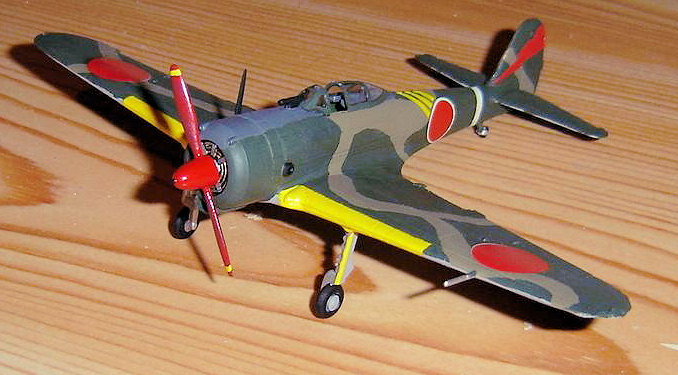
Arii/LS Ki-43-I 'Hayabusa'
| KIT #: | 53001 |
| PRICE: | @ $3.50 |
| DECALS: | yes |
| REVIEWER: | Zac Yates |
| NOTES: | A really fun build. |

| HISTORY |
The Nakajima Ki.43 Hayabusa (which translates to “peregrine falcon”, but was known to the Allies as “Oscar”) was the most numerous fighter produced for the Imperial Japanese Army during World War Two, and was second only to the legendary A6M Reisen in terms of total production.
One Oscar, #750, was found intact by a group of Allied soldiers led by New Zealander Denys Hamilton four miles from Vunakanau Airfield on Truk Island. In 1945 she was shipped to Australia and over the next half-decade saw its way through a succession of private owners including the legendary Sid Marshall, before ending up in the hands of Tim Wallis of Wanaka, New Zealand.
After 10 months of “blind” but solid restoration work by couple Jan Bullock and Doug James, the aircraft was rolled out as practically airworthy on September 21 1995. For the first time since 1945 her engine was run, and the event was cause for considerable celebration for the Alpine Fighter Collection team. Due to her extreme rarity the decision was made that the Ki.43 would not be flown, but remain only taxiable.
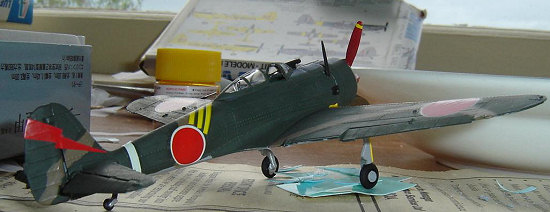 This was ignored
somewhat at the next Warbirds Over Wanaka airshow when, on March 29 1996, pilot
Simon Spencer-Bower took #750 on a high-speed taxi along the runway and, to
everyone’s amazement, lifted her briefly into the air. This was the first time
an Oscar had flown since the end of hostilities in 1945. However, this remains
the only time an original Ki.43 has flown – thanks to Herb and George
Tischler of the Texas Airplane Factory a batch of new-build Oscars are being
completed for various customers, but that’s another story.
This was ignored
somewhat at the next Warbirds Over Wanaka airshow when, on March 29 1996, pilot
Simon Spencer-Bower took #750 on a high-speed taxi along the runway and, to
everyone’s amazement, lifted her briefly into the air. This was the first time
an Oscar had flown since the end of hostilities in 1945. However, this remains
the only time an original Ki.43 has flown – thanks to Herb and George
Tischler of the Texas Airplane Factory a batch of new-build Oscars are being
completed for various customers, but that’s another story.
In 1999 the AFC’s Oscar was sold to the Flying Heritage Collection in the US.
I will always remember this particular Oscar as the video of Wanaka 96 was the first I ever owned, and I knew I was witnessing something special when the little green and brown plane lifted off the ground. As part of my ongoing Project AFC (to build each of the AFC’s aircraft as they were on January 1 1996), as well as to realise a longtime dream, I knew I had to build Oscar. What I didn’t know was that I’d have a ball doing it!
| THE KIT |
 This appears to be
a typical child of the model-building Sixties: three sprues of nice big rivets,
panel lines worthy of employment on the Somme, and moveable control surfaces.
Oh, I almost forgot: engraved Hinomarus in all six positions too! Great fun
considering the kit decals only came with four of them! In all there are 27
pieces I grey plastic and three clear. A nice touch is the canopy is also
moveable, allowing you to open and close it as you want. It appears that at some
point the moulds may have allowed for retractable undercarriage too, but now
they are simply “down”.
This appears to be
a typical child of the model-building Sixties: three sprues of nice big rivets,
panel lines worthy of employment on the Somme, and moveable control surfaces.
Oh, I almost forgot: engraved Hinomarus in all six positions too! Great fun
considering the kit decals only came with four of them! In all there are 27
pieces I grey plastic and three clear. A nice touch is the canopy is also
moveable, allowing you to open and close it as you want. It appears that at some
point the moulds may have allowed for retractable undercarriage too, but now
they are simply “down”.
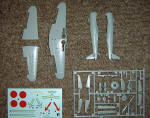 Speaking of
decals, the kit came with options for two examples with slightly differing
paintjobs (unfortunately I can’t tell you the exact details as the instructions
are in Japanese). However, for this build I would only use the supplied
Hinomarus and the white stripe for the rear fuselage.
Speaking of
decals, the kit came with options for two examples with slightly differing
paintjobs (unfortunately I can’t tell you the exact details as the instructions
are in Japanese). However, for this build I would only use the supplied
Hinomarus and the white stripe for the rear fuselage.
I’m not normally the sort of person to compare a kit to scaled plans of the subject, and this hasn’t yet changed. All I know is it looks like an Oscar, and that’s good enough for me! Time to rip into it then!
| CONSTRUCTION |
I decided to start with the cockpit. Unfortunately, all this meant was painting the four pilot positioning poles and fuselage sides Tamiya Flat Green. That’s right – no seat, no floor, no stick, no control panel, no problems! I’m unsure if there are any resin aftermarket kits for this and Hasegawa’s Ki.43, and I’ve no doubt that there are some amongst us who will turn this kit into a real stunner given half the chance. But I digress. I was planning on allowing quick and easy removal of the pilot as I wanted, so I decided to just leave him out.
The wheel wells were painted JA Green (according to my major reference the wells on the real thing were “Dark Green”), and the three-piece wings cemented together. At first I was planning on leaving the ailerons with their designed range of motion, but then I thought instead to have them set permanently, albeit at a slight angle (indicating the stick wasn’t perfectly centered when the pilot had gotten out). The three-piece-each horizontal stabilisers were at this point removed from the sprue by X-Acto blade, cleaned up and cemented together. The fuselage halves were also joined, and the rudder trapped between then. After being held by a clothed peg on the tail wheel, the now-dry fuselage had the tailplanes attached (including the large cylinder which allowed for elevator movement) and was set aside.
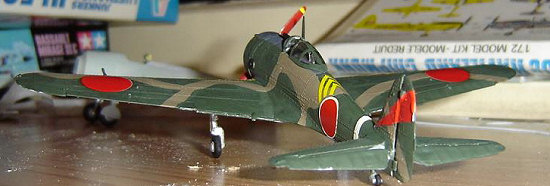 The engine
supplied was a nice representation of the Ki.43’s Ha.25 14-cylinder radial,
which was cemented directly into the engine cowling. Anyone familiar with the
Ki.43 will be aware of the Ha.25’s distinctively-coloured oil cooler. In reality
it was a bronzy colour, but due to a distinct lack of anything resembling that
colour I just substituted Gold Leaf. Not authentic, I know, but it looks good!
The engine was completely painted Flat Black whilst on the sprue (as was the
interior of the cowl), then Chrome Aluminium was lightly applied to the six
rectangular parts on the surface, and then the Gold Leaf onto the oil cooler
itself. The result, very satisfying by my standards, can be seen in the
accompanying photography. When dry, the engine was removed from the sprue and
cemented into the cowl.
The engine
supplied was a nice representation of the Ki.43’s Ha.25 14-cylinder radial,
which was cemented directly into the engine cowling. Anyone familiar with the
Ki.43 will be aware of the Ha.25’s distinctively-coloured oil cooler. In reality
it was a bronzy colour, but due to a distinct lack of anything resembling that
colour I just substituted Gold Leaf. Not authentic, I know, but it looks good!
The engine was completely painted Flat Black whilst on the sprue (as was the
interior of the cowl), then Chrome Aluminium was lightly applied to the six
rectangular parts on the surface, and then the Gold Leaf onto the oil cooler
itself. The result, very satisfying by my standards, can be seen in the
accompanying photography. When dry, the engine was removed from the sprue and
cemented into the cowl.
The wing had its clothes pegs removed and it was cemented to the fuselage. Set aside once more, I turned my attention to the one-piece spinner and prop. Oscar 750 has/had a red spinner and red/brown prop blades. Once more, my far from complete collection of Tamiya acrylics is without a Red/Brown, so I simply painted the whole piece with two coats Red and drybrushed the blades Flat Brown. Far from ideal, yes, but again it’s good enough for me. The near-tip stripes are two coats of Lemon Yellow applied with my finer brush. The tip protruding from the spinner was painted Flat Black, as per my pictures of the full-scale subject.
At this point, I
thought it wise to start on the undercarriage. The entire leg was painted Chrome
Aluminium (as per Wanaka Warbirds’ colour guide) with the oleo cover Sky Grey
(yes, the leg/cover is moulded as one piece). Another coat was later necessary
once the first had dried. Following this, a thin sliver of Lemon Yellow was
applied to the front of each oleo cover as the full-size aircraft had a
leading-edge identification stripe on each wing which extended to partially
cover the oleo cover. The wheels 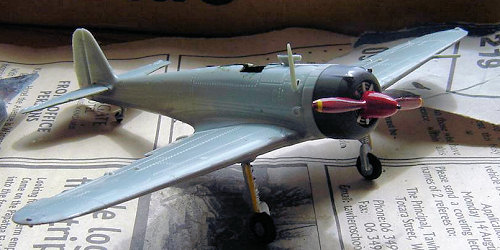 were painted overall Flat Black (two coats),
and the small wheel centres were painted Sky Grey. When the three individual
components of each undercarriage leg were dry, the wheels were removed from the
sprue and cemented to the leg, and then the same with the wheel centres. Some
touch ups were performed on each tyre with Flat Black, and Chrome Aluminium
“wheels” were applied to the centres of the tyres.
were painted overall Flat Black (two coats),
and the small wheel centres were painted Sky Grey. When the three individual
components of each undercarriage leg were dry, the wheels were removed from the
sprue and cemented to the leg, and then the same with the wheel centres. Some
touch ups were performed on each tyre with Flat Black, and Chrome Aluminium
“wheels” were applied to the centres of the tyres.
By now the cowling was sitting all alone, doing nothing but gather dust, so I decided to do some JA Green on it. Two coats of this was applied to all but the area between the two machinegun apertures, which was painted Dark Grey (again two coats). Once this was dry (and after much careful handling) the prop shaft was inserted and cyanoacrylate applied to the tip, and the prop attached to this.
The “power-egg” was cemented in its rightful place on the airframe, and set aside for 10min to dry.
| COLORS & MARKINGS |
What I’ve found over the course of my 12 or so years modelling is that Tamiya’s JA Green can pass for pretty much any dark green used by any air arm at any time! Thus, my trusty JA was brought out for two coats on the uppers of the Ki.43-I. Two coats of Sky Grey had previously been applied to the underside (with touch ups). For some unknown reason the green would get all lumpy when I went to do a second coat on the lighter areas, so I opted to simply “splat” some JA Green on the affected areas which resulted, surprisingly enough, in a nice even finish.
The Dark Grey was brought out one last time to do the anti-glare panel extending from just behind the cockpit to the firewall, and the gun sight was painted Flat Black (as was the aerial mast).
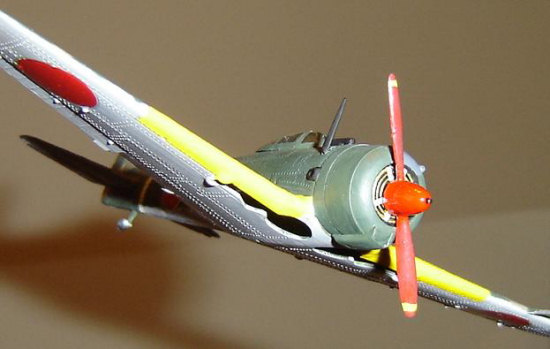 Oscar 750 had a
distinctive colour scheme which I suspect was “improved” in the field – the
(what I believe to be) factory finish of all over dark green had a disruptive
light brown “wave” applied, which I replicated with my medium-width brush and a
bottle of Tamiya’s Khaki. My images of the aircraft were limited to mostly of
its port side, so I had to improvise and just plain guess. The result can be
seen here.
Oscar 750 had a
distinctive colour scheme which I suspect was “improved” in the field – the
(what I believe to be) factory finish of all over dark green had a disruptive
light brown “wave” applied, which I replicated with my medium-width brush and a
bottle of Tamiya’s Khaki. My images of the aircraft were limited to mostly of
its port side, so I had to improvise and just plain guess. The result can be
seen here.
The windscreen, which had been given a couple of coats of JA Green and touch ups, was cemented in place. I would have by this time attached the part which allowed the sliding portion of the canopy to, well, slide, but I had lost it. Never fear though, as the “rail” was so tight the canopy will not come out unless pulled by human hands.
When it came to decals I hit a bit of a snag. As mentioned previously the included decal sheet has only the four wing Hinomarus and NO FUSELAGE ONES! Luckily for this Kiwi, a mate of mine Stateside had sent me a Hinomaru sheet for my Tora, Tora, Tora Harvard/Zero conversion, which just so happened to include a white-edged Hino of perfect size for a Hayabusa! (Your editor should point out that early in the war, Army aircraft often did not wear fuselage insignia so not having them would be correct).
Yet again I thought I’d hit a snag when it came to two features particular to this aircraft: three yellow half-chevrons on the top rear fuselage, and a red lightning bolt on the tail. I was originally planning on painting these myself, but once more my filled-to-the-brim decal box came to my rescue! I discovered some yellow striping which originated in Italeri’s 1:72 F-51D kit which I duly trimmed and applied to the fuselage, and I took to the same company’s Ju52 decals to produce the lightning bolts. Due to some excess yellow I had to touch up for one last time with JA Green, and voila! She was done!
Total building time? Would you believe I started this kit just before noon on Friday and had it finished a tad after 6pm?
| CONCLUSIONS |
This was one of the most fun builds I have done in a very, very long time. After wanting to make this Oscar for just over a decade, it’s done and I’m very satisfied. She may not be the finest example of the Hayabusa in miniature to have been built, or the most accurate, but I’m extremely pleased with the end result. To see this little baby sitting on my shelf fills me with immense pride, and that’s the best feeling around.
Review kit courtesy of Evan Mayerle (traded in exchange for an Airfix TSR.2) {A partial trade I hope, as Airfix TSR.2s are fetching $100 on the auction sites. Ed}
November 2006
| REFERENCES |
MORRIS, Gerard S and RUSSELL, Warren P: Wanaka Warbirds: Sir Tim Wallis’s Alpine Fighter Collection Reed Publishing 1998
WALLIS, Prue: 'The Story of Nakajima Ki43i No. 750 (Oscar)' http://www.nzfpm.co.nz/articles/oscar.htm (originally published in NZ WINGS magazine 1995)
Warbirds Over Wanaka Warbirds Over Wanaka/Classic Wings Downunder 1996
Copyright ModelingMadness.com. All rights reserved. No reproduction in part or in whole without express permission from the editor.
If you would like your product reviewed fairly and fairly quickly, please contact the editor or see other details in the Note to Contributors.